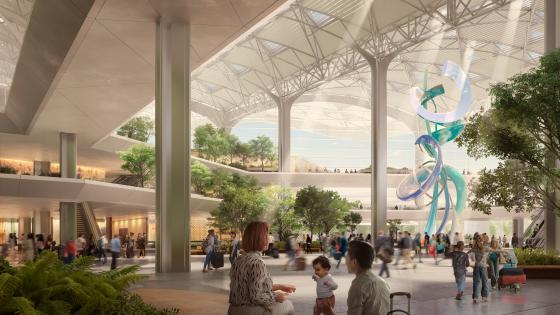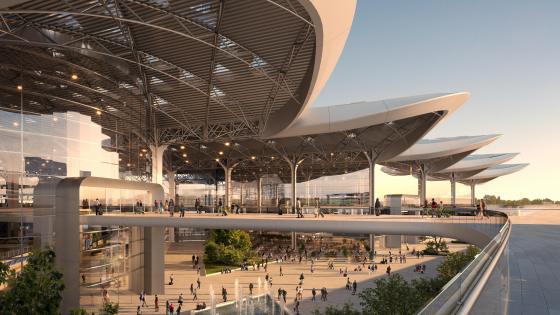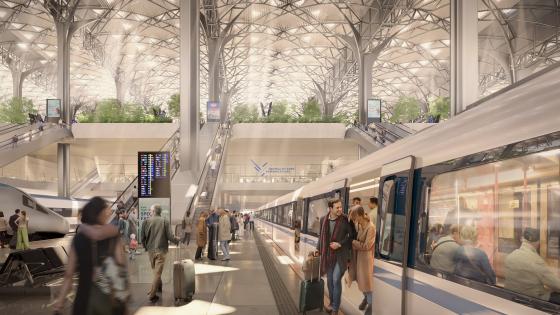Centralny Port Komunikacyjny (CPK) has published the concept design for CPK Airport, showing the terminal, main railway station and public transport interchange.
Approval of the airport's concept design, prepared by the British consortium Foster + Partners and Buro Happold, means that the CPK project has moved to the next stage, i.e. development of the construction project.
Marcin Horała, deputy minister for funds and regional policy, and government plenipotentiary for CPK, said of the design: “I am convinced that this modern architecture, which was developed with world-leading designers, will create gigantic business opportunities, attract foreign investments and stimulate economically not only Poland, but the entire region of Central and Eastern Europe.”
“We are presenting the architectural concept of the terminal for the first time. We are demonstrating how we are going to ensure passenger comfort and how we will combine different modes of transport in one place. As of today, we know what the terminal, the heart of CPK and the aviation gateway to the world, is going to look like. For those arriving, this will be the first experience of our country. We are also unveiling the first railway station so closely integrated with an airport,” Horała added.

Located before security, the atrium will be accessible to everyone
The design
The centrepiece of the multimodal interchange is an atrium, seamlessly connecting the airport terminal, railway station, and other modes of transport under a singular, unifying canopy. The atrium is the ‘foreground of the airport’, the link between the terminal and the railway station – an accessible space where all passengers meet, regardless of which mode of transport they are using.
The atrium is located before security control, meaning it is accessible to all. It is also a place where employees and guests of the nearby Airport City will spend their time. The interface between the terminal and the surrounding area is unique, CPK says. Typically, terminal buildings are difficult to access on foot. CPK’s solution creates pedestrian-friendly areas between Airport City and the airport’s infrastructure.
Our design for CPK is centred on the passenger. The ambition is to create an accessible, calm and legible building that enhances the experience of travel
The airport’s passenger terminal, covering an area of approximately 400,000 m2, will be located on two levels, and arrival and security checks are both Schengen and non-Schengen. Once they have been through security, non-Schengen passengers will descend to another level, where they will have their own part of the terminal, with restaurants and shops.
“Our design for CPK is centred on the passenger. The ambition is to create an accessible, calm and legible building that enhances the experience of travel,” said Grant Booker, head of studio, Foster + Partners.
“The terminal’s minimal level changes and generous structural spans create clear lines of sight – from landside to airside – making it extremely easy to navigate. The vaulted roof fills the space with light and leads passengers through the building, guiding them towards their destinations. Bringing together three modes of transport in one place – and integrating a new railway station that is part of a national high-speed rail system – we believe that CPK will completely transform the way people travel across Poland and become a powerful new gateway to Europe and the rest of the world,” he added.

There will be two-way moving walkways throughout the terminal
The terminal will directly connect to four modular piers, with the potential for future expansion according to market demand. In all areas of the terminal, there will be two-way moving walkways for passengers, designed to minimise transfer times.
In addition to conventional check-in desks, the terminal will be equipped with self-service check-in stations, a self-bag-drop and kiosks with biometric capabilities. Both security and document control will be fully automated with CT scanners and automated gates.
The railway station
The CPK railway station will accommodate the needs of CPK’s operations and serve as a national transport hub, integrating rail connections from major cities in Poland. It will consist of six underground platforms (12 tracks) serving regional and long-distance trains. The platforms will be covered in such a way that it will be possible to reach the station, which will be located in the atrium on the north side of the terminal and connected to it, comfortably and without risk of being exposed to the elements.
Direct, convenient access from the railway station to both the bus station and Airport City will be provided. The interchange will feature bus bays, waiting areas equipped with ticket counters, and retail facilities. Hotels are planned in the vicinity of the bus station, marking the initial developments of Airport City.

The first phase of the airport, i.e. two parallel runways and infrastructure to handle 40 million passengers, is expected to be operational in 2028. The CPK General Plan assumes that the airport will be expanded in a modular manner afterwards. According to IATA forecasts, the airport could handle up to 65 million passengers in 2060.
Images: Centralny Port Komunikacyjny
